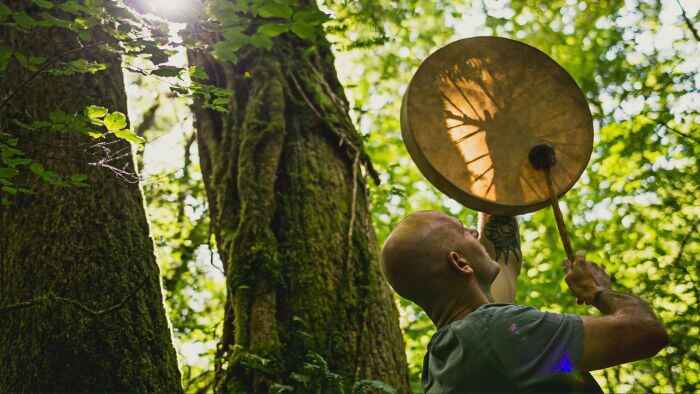The 8 Spiritual Principles That Guide Shamanism

Unpacking Shamanism and Becoming a Shaman
I wanted to talk to you about something that gets a lot of air time at the moment, especially online and in the spiritual healing field, and that's the concept of shamanism and being a shaman.
There are a lot of people that ask, how do I become a shaman? What is Shamanism? How do I practice shamanism? And I wanted to spell out a few myths about shamanism and shamanic practices and actually break it down so that people are super clear.
Point 1
Firstly, shamanism is available to all of us practicing healing work or connection spiritually. Having a 'shaman perspective' is developing healing that's in line with the roots of shamanism. That's what I teach with my husband James. We practice energy medicine, which has it's foundation in shamanic roots or shamanic practices.
Point 2
What I wanted to break down though is what actually is that practicing a shamanic way of life doesn't mean you are a shaman. I'm not a shaman. If you wanna call yourself a shaman or you wanna become a shaman, that's a choice and that's a calling, and you can try and go out and do that. But what I understand of my perspective from the West is that being a shaman probably means you have grown up in an indigenous culture where your whole world is metaphysics and you have been taught the shamanic way of life in your whole tribe and culture. And that you were nurtured from a very young age and taught a lot about the roots of shamanism and started your shamanic practices from a very young age.
So that then by a certain age, if you were considered someone that had visions or you were a healer or you were a seer or someone that was considered quite connected to the shamanistic life, you might actually practice shamanism and become what they would call a shaman for their tribe. That is a rite of passage, for indigenous cultures. Growing up in the West. I wasn't exposed to that. I didn't have that in my birth. I wasn't educated in shamanic practices. I didn't have that in my early childhood development. So now as an adult, I am learning and practicing shamanism as best I can.
So I've got eight different principles to shape what shamanism actually is and how to be in line with shamanic practice. Lets go.
8 Spiritual Principles That Guide Shamanism
1. Everything is alive and everything has a spirit.
Shamanism basically says that everything is energy, everything is created, you can create and you can un-create or destroy something. Everything has a start and an end, and everything has day and night. So, you know, a tree has a spirit, the spirit of a house has an expression. You as a human have a spirit, a cat has a spirit, everything has an energy and a thought and a creation in the metaphysical or the invisible world that can be communicated to.
2. Everything that is alive can be communicated with.
You can talk to a tree, you can talk to an animal, and you can talk to a human in their own individual languages and energies. And that does require that you open up your original senses or your intuitive senses so that you're seeing, you're feeling, you're connecting, you're doing things on an intuitive and a psychic vibrational level. As you know, in a tree doesn't speak English and a dog doesn't speak the English language. So there's another way in to connect and communicate with these alive beings and spirits.
3. Dark and Light – shamanism requires one to face shadows, fear, and the dark arts
Shamanism actually requires us to face the shadow, to face fear. You know, there's always an aspect of a lone walk in the dark to face fear. And you actually look at your greatest fear, which is why in a lot of cultures they might do vision quests or spend time out in the dark alone to do this. I've heard of the ritual of "bury up to the neck" and being left alone for days. That is a well known shamanic practice. Being out there all alone as if there's a death process going on and you have to go through that dark night of the soul. You really have to do face shadow and face darkness and that can be scary. It can be other energies that you're facing or your own internal demons, whatever that is.
Shaman practice is pretty much the OPPOSITE of the positive psychology movement where everything is about being positive. That's just not the case in shamanism. Shamanism has light and dark.
4. Nature and its patterns/cycles - honouring seasons and directions.
Shamanism has patterns in nature that govern the cycle. There's a knowing field, there's an organizing principle, there are seasons- earth and elements, fire water, earth, air. Everything has its own cycles and seasons and we can utilize nature as a metaphor for life. We work with the concepts of nature. Not only directly ourselves for example, for moons or new moons, but also looking at the shape and patterns of blueberries, having the star pattern and spiral fruits and things like that. There's a whole gamut of nature being our greatest teacher.
5. Timeline therapy – past, present and future are all existing at the same time
Shamanism also says that we can do timeline therapy, we can visit the past, present and future, and we realise time isn't linear. There is some sort of non-linear energy access points that shows everything is happening all at once. An aspect of deep timeline therapy. When you study shamanism you can visit past, present, and future and make changes to any of those timelines and repair fractures. In fact in shamanic practices like journeywork - there is no linear time, it is more multidimensional.
6. The 3 Worlds of journeying – lower world, middle world, and upper world.
Now, I've always been taught that when you do a guided journey, you can either go into the lower world, which is the deep subconscious, or the underground, which is the more shadowy side. You can journey in the everyday world, which is the middle world, which is just everyday consciousness. Or you can go up into more cosmic spirit world, which is the upper world. So it talks about all these different worlds that we can travel and journey into. So again, that's another thing that the shamanic world or perspective teaches us.
7. Energy and vibration (the world of metaphysics) is where true healing takes place.
This is where healing takes place in the human body or, in animals or whatever you're trying to do. Energy can get stuck, blocked, fractured, and you can have energy cords between people that need cutting. You can have energy weapons, you can have blocked fields.
So Shamanism gives you the ability to shift and change and heal energy so that it comes back to have balance and harmony. Remove cords, stagnation, illness.
Hence, energy medicine or any energy healing does have on some level, its roots in shamanism because that's how energy works to then be healed and corrected to come into the physical and heal.
8. One foot in both worlds - the spiritual and the physical world.
Mediating between the world of spiritual and physical. The Native American Indians call it the Great blue road, which is the world of metaphysics.
And we have the Great red road, which is the physical everyday world. And someone that lives in a shamanistic way walks with a foot in both worlds. The red and the blue. So you can be in the metaphysical world and you can be in the physical and when you bridge those two together, you're honoring both.
And I think that's true if you want visions, insights or healing. If you want to go deeper into your own spiritual journey, you have to walk with a foot in both worlds and start to bridge that shaman perspective. We are in both the invisible and, and the visible, the metaphysical and the physical.
Hoping those eight points give you an idea of what shamanism is. And you know, we do use the shaman practices as the backbone of our energy medicine training amongst lots of other different things that we've learned over the years.
No one has the rights over not does anyone own the word shaman. No one has the right to own a shaman's perspective or their practices. This is a universal energy that's available to every single human, non-human, whatever on this planet.
So, you know, it's really important to think if you are going to work with shamanistic roots or practices, that there is a dark and light to it. Healing is light. Voodoo is the dark.
You know, if you're doing the healing, you're bringing people back to balance in a good way. If you're doing voodoo, you're interrupting someone else. Seances are an example of something that's playing on the darker side of the shamanistic world. I never touch that.
So, what I wouldn't encourage you to do any dark arts/magic if you're looking at shamanism. Your job is to really understand dark and light and then choose to play in the light. I hope that helps and clears anything up.
I'd love to hear any questions that you might have on all things shamanic.
Debbie Pask


0 comments
Leave a comment
Please log in or register to post a comment